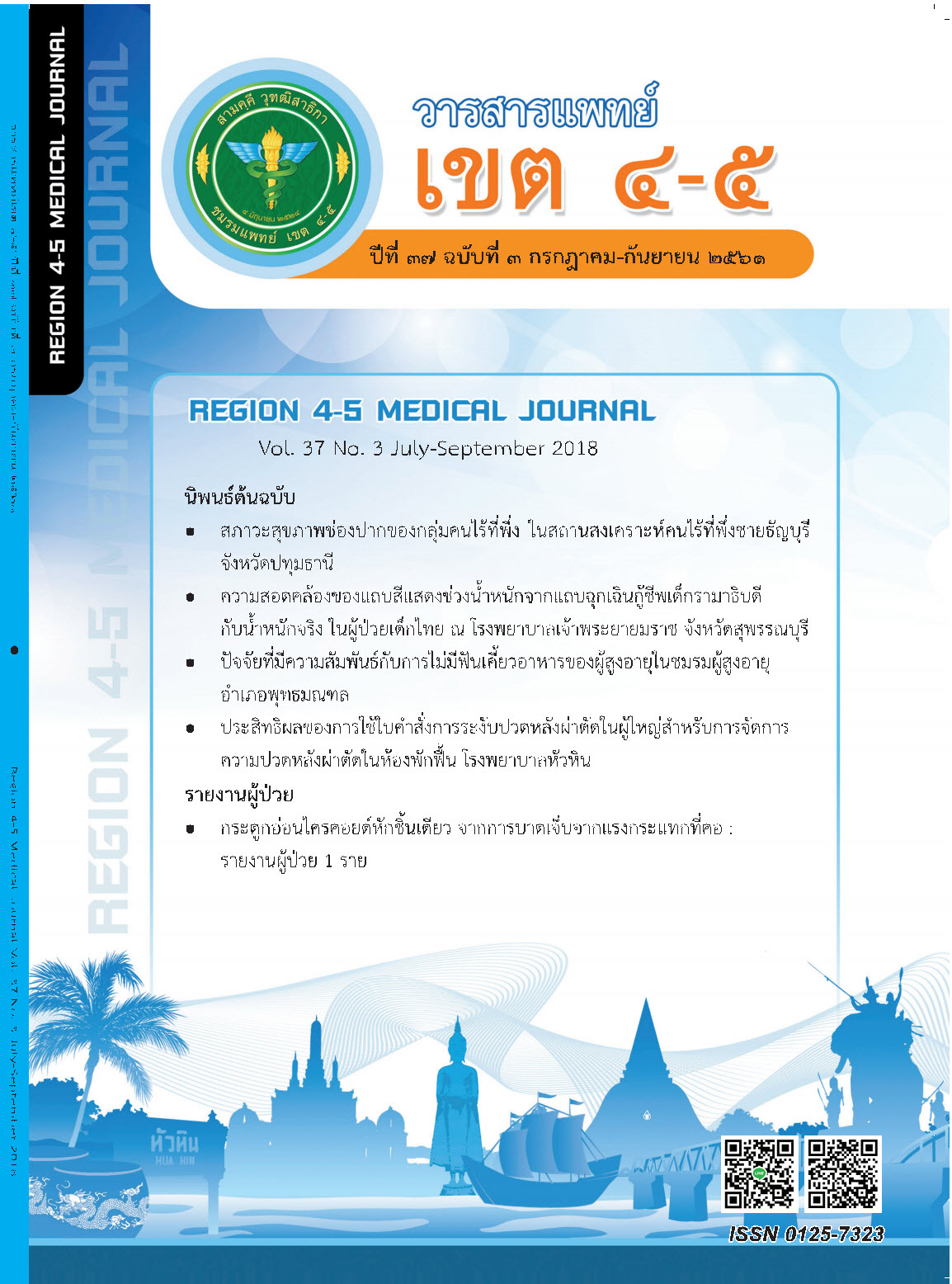การศึกษาเปรียบเทียบอัตราการใช้ยาปฏิชีวนะ เพื่อรักษาผู้ป่วยติดเชื้อทางเดินหายใจส่วนบนและหลอดลมอักเสบเฉียบพลัน ภายหลังการดำเนินโครงการใช้ยาปฏิชีวนะอย่างสมเหตุผลมาแล้ว 7 ปี ในโรงพยาบาลสามชุก สุพรรณบุรี
คำสำคัญ:
การติดเชื้อทางเดินหายใจส่วนบน, หลอดลมอักเสบเฉียบพลัน, การสั่งยาปฏิชีวนะ, การดื้อยาปฏิชีวนะบทคัดย่อ
ปัญหาเชื้อดื้อยาเป็นปัญหาสำคัญที่หลายประเทศให้ความสนใจ มีความเกี่ยวข้องกับการใช้ยาปฏิชีวนะที่ไม่เหมาะสมและเกินความจำเป็น โดยส่วนมากพบในกลุ่มผู้ป่วยติดเชื้อทางเดินหายใจส่วนบนและหลอดลมอักเสบเฉียบพลัน การลดการใช้ยาปฏิชีวนะจึงเป็นสิ่งสำคัญที่จะลดปัญหาเชื้อดื้อยาลงได้
วัตถุประสงค์: เพื่อเปรียบเทียบอัตราการใช้ยาปฏิชีวนะในกลุ่มผู้ป่วยติดเชื้อทางเดินหายใจส่วนบนและหลอดลมอักเสบเฉียบพลัน ที่มารักษาแบบผู้ป่วยนอกระหว่างปีงบประมาณ 2553 และ 2560
วิธีการศึกษา: เป็นการศึกษาแบบย้อนหลัง (retrospective comparative study) ในผู้ป่วยติดเชื้อทางเดินหายใจส่วนบนและหลอดลมอักเสบเฉียบพลัน ที่มารักษาแบบผู้ป่วยนอกตามรหัสโรคที่กำหนด 2 กลุ่ม คือ ปีงบประมาณ 2553 จำนวน 9,591 ครั้ง และปีงบประมาณ 2560 จำนวน 9,286 ครั้ง วิเคราะห์ข้อมูลด้วยโปรแกรมสำเร็จรูปทางสถิติ นำเสนอข้อมูลด้วยความถี่ ร้อยละ ค่าเฉลี่ย ส่วนเบี่ยงเบนมาตรฐาน และ chi-square test
ผลการศึกษา: การใช้ยาปฏิชีวนะปีงบประมาณ 2553 และ 2560 พบว่าลดลง (ร้อยละ 73.1 และ 38.4 ตามลำดับ p < 0.001) ช่วงอายุที่มีการใช้ยาปฏิชีวนะมากที่สุดคือ 18 ถึง 49 ปี (ร้อยละ 77.2 และ 48.2 ตามลำดับ p < 0.001) การใช้ยาปฏิชีวนะตามการวินิจฉัยในปีงบประมาณ 2553 และ 2560 ลดลงตามลำดับ ใน acute nasopharyngitis (ร้อยละ 13.0 และ 4.3; p <0.014), acute pharyngitis (ร้อยละ 92.7 และ 77.3; p <0.001), acute upper respiratory tract infection of multiple and unspecified sites (ร้อยละ 38.5 และ 12.3; p<0.001), acute bronchitis (ร้อยละ 66.9 และ 45.9; p <0.001) และ otitis media and perforation of tympanic membrane (ร้อยละ 95.7 และ 83.8; p=0.001) แต่การวินิจฉัย acute tonsillitis มีการใช้ยาเพิ่มขึ้น (ร้อยละ 82.7 และ 87.3; p <0.001) ยาปฏิชีวนะที่ใช้มากที่สุดในปีงบประมาณ 2553 และ 2560 คือ กลุ่ม penicillin (ร้อยละ 73.5 และ 70.5 ตามลำดับ p <0.001)
สรุป: การใช้ยาปฏิชีวนะในกลุ่มลดลงในปีงบประมาณล่าสุดที่ทำการศึกษา ควรติดตามเพื่อให้ลดลงอย่างต่อเนื่องและอยู่ในเกณฑ์ที่เหมาะสมต่อไป
เอกสารอ้างอิง
2. ภาณุมาศ ภูมาศ, สุพล ลิมวัฒนานนท์. ผลกระทบด้านสุขภาพและเศรษฐศาสตร์จากการติดเชื้อดื้อยาต้านจุลชีพในประเทศไทย. วารสารวิจัยระบบสาธารณสุข 2555;6:352-60.
3. Riedel S, Beekmann SE, Heilmann KP, et al. Antimicrobial use in Europe and antimicrobial resistance in Streptococcus pneumoniae. Eur J ClinMicrobiol Infect Dis 2007;26:485-90.
4. Earnshaw S, Monnet DL, Duncan B, et al. European Antibiotic Awareness Day, 2008 – the first Europe-wide public information campaign on prudent antibiotic use: methods and survey of activities in participating countries. Euro Surveill 2009;14:19280.
5. Petersen I, Hayward AC. Antibacterial prescribing in primary care. J Antimicrob Chemother 2007;60 suppl 1:i43-7.
6. Gonzales R, Malone DC, Maselli JH, et al. Excessive antibiotic use for acute respiratory infections in the United States. Clin Infect Dis 2001;33:757-62.
7. วิษณุ ธรรมลิขิตกุล. คู่มือการรักษาโรคติดเชื้อแบคทีเรียด้วยยาปฏิชีวนะที่โรงพยาบาลส่งเสริมสุขภาพตำบล [อินเทอร์เน็ต]. 2558 [วันที่สืบค้น 25 พฤษภาคม 2561]. เข้าถึงได้จาก URL: http://kb.hsri.or.th/dspace/handle/11228/4275
8. พนาวรรณ คุณติสุข. การใช้ยาปฏิชีวนะ (Antibiotic drugs) อย่างถูกต้องและเหมาะสม. วารสารโลหิตวิทยาและเวชศาสตร์บริการโลหิต 2554;21:193-6.
9. Meneghetti A. Upper Respiratory Tract Infection: Practice Essentials, Background, Pathophysiology [Internet]. 2018 [cited 2018 May 25]. Available from: URL: https://emedicine.medscape.com/article/302460-overview#a2
10. Fayyaz J. Bronchitis: Practice Essentials, Background, Pathophysiology [Internet]. 2018 [cited 2018 May 25]. Available from: URL: https://emedicine.medscape.com/article/297108-overview
11. คณะทำงานขับเคลื่อนการพัฒนาระบบการผลิตและพัฒนากำลังคนด้านสุขภาพ เพื่อการใช้ยาอย่างสมเหตุผล. คู่มือการเรียนการสอนเพื่อการใช้ยาอย่างสมเหตุผล. นนทบุรี: สำนักงานคณะกรรมอาหารและยา กระทรวงสาธารณสุข; 2560.
12. Suda KJ, Hicks LA, Roberts RM, et al. Trends and seasonal variation in outpatient antibiotic prescription rates in the United States, 2006 to 2010. Antimicrob Agents Chemother 2014;58:2763-6.
13. Kim JA, Park J, Kim BY, et al. The trend of acute respiratory tract infections and antibiotic prescription rates in outpatient settings using health insurance data. Korean J Clin Pharm 2017;27:186-94.
14. กระทรวงสาธารณสุข. ร้อยละการใช้ยาปฏิชีวนะในโรคติดเชื้อที่ระบบการหายใจช่วงบนและหลอดลมอักเสบเฉียบพลันในผู้ป่วยนอก ระดับโรงพยาบาล (RI) ปีงบประมาณ 2560 [อินเทอร์เน็ต]. 2560 [วันที่สืบค้น 26 พฤษภาคม 2561]. เข้าถึงได้จาก URL: https://hdcservice.moph.go.th/hdc/reports/report.php?source=pformated/format1.php&cat_id=03b912ab9ccb4c07280a89bf05e5900e&id=d8fa7339c10c7eccd02529be81ebb8a5
15. Sumpradit N, Chongtrakul P, Anuwong K, et al. Antibiotics Smart Use: a workable model for promoting the rational use of medicines in Thailand. Bull World Health Organ 2012;90:905-13.
16. Saengcharoen W, Lerkiatbundit S, Kaewmang K. Knowledge, attitudes, and behaviors regarding antibiotic use for upper respiratory tract infections: a survey of Thai students. Southeast Asian J Trop Med Public Health 2012;43:1233-44.
17. Grijalva CG, Nuorti JP, Griffin MR. Antibiotic prescription rates for acute respiratory tract infections in US ambulatory settings. JAMA 2009;302:758-66.
18. Harris AM, Hicks LA, Qaseem A. Appropriate Antibiotic Use for Acute Respiratory Tract Infection in Adults: Advice for High-Value Care From the American College of Physicians and the Centers for Disease Control and Prevention. Ann Intern Med 2016;164:425-34.
19. Lieberthal AS, Carroll AE, Chonmaitree T, et al. The diagnosis and management of acute otitis media. Pediatrics 2013;131:e964-99.
20. Higashi T, Fukuhara S. Antibiotic prescriptions for upper respiratory tract infection in Japan. Intern Med 2009;48:1369-75.
21. Neumark T, Brudin L, Engstrom S, et al. Trends in number of consultations and antibiotic prescriptions for respiratory tract infections between 1999 and 2005 in primary healthcare in Kalmar County, Southern Sweden. Scand J Prim Health Care 2009;27:18-24.
ดาวน์โหลด
เผยแพร่แล้ว
รูปแบบการอ้างอิง
ฉบับ
ประเภทบทความ
สัญญาอนุญาต
ลิขสิทธิ์บทความเป็นของผู้เขียนบทความ แต่หากผลงานของท่านได้รับการพิจารณาตีพิมพ์ลงวารสารแพทย์เขต 4-5 จะคงไว้ซึ่งสิทธิ์ในการตีพิมพ์ครั้งแรกด้วยเหตุที่บทความจะปรากฎในวารสารที่เข้าถึงได้ จึงอนุญาตให้นำบทความในวารสารไปใช้ประโยชน์ได้ในเชิงวิชาการโดยจำเป็นต้องมีการอ้างอิงถึงชื่อวารสารอย่างถูกต้อง แต่ไม่อนุญาตให้นำไปใช้ในเชิงพาณิชย์




